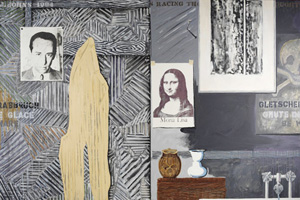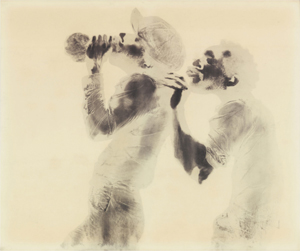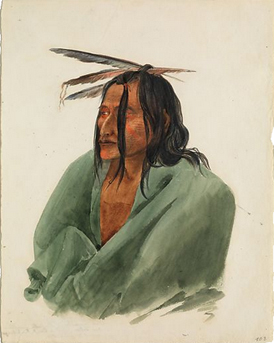Walking the Dog
John Haberin New York City
Blockbusters and Restraint: 2021 in Review
Art after the lockdown was like a dog walking on its hind legs. It was not necessarily done well, but you were surprised was to find it done at all.
Excuse me for updating an old joke, but art in 2021 deserves some credit, however well went. Museums needed the year just to recover their balance. Galleries were lucky to survive at all. I hate picking winners, even the year's best, and a critic should offer something more. And Covid-19 gives me yet another excuse to avoid it. Still, art had a stellar year. 
Not just simple pleasures
I might have settled for token accomplishments. It was enough to return to galleries without an appointment and to museums with shorter lines. I no longer have Vincent van Gogh and Starry Night all to myself, like Vincent van Gogh in Saint-Rémy, but I can still see it rather than the back of someone's head. Galleries, meanwhile, continued the move to Chatham Square and Tribeca. Of the casualties, more live on with "virtual exhibitions" than I ever expected. Never mind that Bushwick is effectively dead.
Who would ask for more? Maybe no one, but the year brought a rush of deferred shows and delayed decisions. Most March New York art fairs completed the shift to early fall, not all of them scaled back. A Bronx biennial and New Museum triennial piled in after an Asia Society triennial, with an "open call" at the Shed, "Greater New York" back at MoMA PS1, and the Whitney Biennial coming soon. If they are starting to feel like art fairs themselves, that is not a healthy trend. Nor is the incessant claim to discover the latest emerging artist.
Recovery brought big shows, too, and I mean big. Jasper Johns filled the largest spaces of not one but two museums, the Whitney and the Philadelphia Museum of Art. Talk about a blockbuster. Was Johns always about the puzzle of art and not the next big thing? The parallel layout seems only right for his incessant doubling. It also defies death, from an artist obsessed with mortality.
For me, it was not just a textbook case. It was the chance of a lifetime, to see and to discuss an artist who shaped my thoughts and the course of a century. Paul Cézanne at MoMA meant nothing less as well. A show of drawings may not often count as a blockbuster. Yet it suits an artist who made every work an ongoing exploration. It also suits his dual insistence on observation and the art of museums, a paradox that has haunted art ever since.
Contemporary art had a blockbuster of its own, with Julie Mehretu at the Whitney—and only a blockbuster will do. Her art is as private and personal as doodling and as ambitious and public as her mural scale. The year's most ambitious dive into history straddles the public and private as well. Medici portraits at the Met chart power and privilege in late Renaissance Italy, but through individuals, in a daze or dressing up. They also reflect Mannerism's turn against the Renaissance itself.
The year brought more literal public spaces, too, on top of the usual outdoor summer sculpture. Little Island on a Hudson River pier is a wealthy man's ego trip, but still a public park. Nearby, across from the Whitney, David Hammons outlines in steel a former warehouse—with memories of the artists who struggled there and lives lost to AIDS. Moynihan Train Hall cannot redeem Penn Station, but it looks great all the same. Hudson Yards is still the worst conceivable public space, but one can now put it in perspective. It would be downright comic had suicides not closed its sculpture to the public.
Thinking about diversity
These may be safe choices, but they are not just straight, white, and male, and they are not alone. Women at the Bronx Museum were "Born in Flames," and the Whitney presented women in mid-century abstraction. Hammons, an African American, also had work at the Drawing Center. It would have been worth seeing just for the irony of first thoughts from the most private and elusive of artists. The center also exhibited Huguette Caland, a Lebanese woman who traffics in body parts and dresses. Now you know how not to dress for an opening.
 In the galleries, Jennifer Packer made a black woman's anger a pleasure. Shahzia Sikander and Asal Peirovi shared their personal histories and love of Islamic art with an allusive precision. Lois Dodd and Anne Buckwalter opened their homes to painting, while Jordan Kasey and Rita Lundqvist added feminist sci-fi fantasies. Margot and Agatha Wojciechowsky took self-taught art to their inner visions. As for men, David Alekhuogie and Remy Jungerman brought an anthropologist's cool eye to cultural diversity.
In the galleries, Jennifer Packer made a black woman's anger a pleasure. Shahzia Sikander and Asal Peirovi shared their personal histories and love of Islamic art with an allusive precision. Lois Dodd and Anne Buckwalter opened their homes to painting, while Jordan Kasey and Rita Lundqvist added feminist sci-fi fantasies. Margot and Agatha Wojciechowsky took self-taught art to their inner visions. As for men, David Alekhuogie and Remy Jungerman brought an anthropologist's cool eye to cultural diversity.
The Brooklyn Museum has a habit of pandering, this year with KAWS, who makes Jeff Koons look sophisticated. Still, good things can slip in under the radar, like Lorraine O'Grady, crashing openings as Mlle Bourgeoise Noire and literally framing a parade in Harlem. If that museum thinks too little, the Jewish Museum can overthink anything. And it did so again with Louise Bourgeois as "Freud's Daughter." It does so, too, with two shows of Nazi-looted art that have little room for artists. Still, there are worse sins than thinking—and thinking about the Holocaust.
Diversity also means rediscovery. The Guggenheim built on recent gallery attention to Etel Adnan in her visionary landscapes and visionary old age, while Sophie Taeuber-Arp at MoMA sums up early modern movements all by herself. She also ranges from puppetry and performance to architecture. These days tapestry stands in for painting, but Emma Amos was there fifty years ago. Gee's Bend quilters like Mary Lee Bendolph were at it earlier still. Her Tribeca show topped the galleries.
Attention to women also led to renewed interest in photography. And that, in turn, drove alternative histories. The Met attempted a comprehensive history of modern photography through women photographers alone. Were they, as the show's title has it, the "new woman"? The Jewish Museum saw much the same history through magazine photography and fashion. Women shaped "The Modern Look" from both sides of the camera.
Galleries brought contemporary women photographers into the picture, including Marianna Rothen, Barbara Probst, and Ming Smith. Smith opened a black woman's Chelsea gallery. She also appeared with the Kamoinge Workshop at the Whitney. Diana Markosian and Gillian Laub at the International Center of Photography asked what it means to be an American. Is this a nation of immigrants or unearned privilege?
Back to the collection
My opening joke's original, from Boswell's life of Johnson in 1791, was critical and condescending, and Samuel Johnson meant it at the expense of "women preachers." So much for women with a voice of their own. Critics, though, always run the risk of old wisdom, myself included. Lists like this one track all the right trends—and trends, even good ones, weigh art down. The Obama state portraits show African American artists at their best. Yet the Brooklyn Museum gives them a near empty hall that all but screams veneration. 
Still, most galleries went about their business, beyond the latest trends. Tom Doyle, it turns out, had an artistic life apart from Eva Hesse. Also in past abstract sculpture, John Chamberlain brought true artistry to crushed automobiles. Others looked back to the nasty edge in Philip Guston, the belated Surrealism of Wilfredo Lam, and the sober early realism of Alice Neel. Between that and a Met retrospective, I still do not know whether she has become a mere formula for portrait painting.
Not all museums were creating blockbusters. Some were just getting things together. Could that be the real best of 2021? The Neue Galerie reopened with its collection, while the Guggenheim trotted out its founder's preference for late Wassily Kandinsky. The Frick moved to the former Whitney Museum, while rebuilding. The Frick Madison is a tribute to both the collection and Marcel Breuer's modern architecture.
MoMA delivered on its promise to rehang the collection each year. Its 2021 "fall reveal" reveals an interest in film and video, while Adam Pendleton in the atrium takes Robert E. Lee off his high horse. The Met created a period room for African American and Native American influences, under the awkward heading of Afrofuturism. It is helpful all the same. The museum also rehung its Chinese wing to evoke the art of solitude and reflection. After all the stress, I could use it.
Even in company, modesty can pay off. The Met made its greatest contribution to diversity with no publicity at all. Small shows in its American wing asked how European artists sought out Native Americans. Did Karl Bodmer find local color and Jules Tavernier a way of life? Few will have noticed, and that could well have salvaged the shows. A debate over white voices speaking for others could have added a dimension or killed the work entirely.
A year-end wrap-up tends to come with bullet points. This one is closer a compendium of what I liked. Could the year have been just that good? And what about next year, when pent-up energy and restraint alike have fallen away? Art in 2022 will have to survive not just Covid-19, but the marketplace. What you admire most may be the first to die.

Of course, this site has reviewed pretty much all this and more at length. I did not review John Chamberlain at Gagosian through February 5, 2022, because of past reviews, including one of Chamberlain in Retrospective. Other dates and locations appear with fuller reviews, with links here. I have modernized Dr. Johnson's language as well as his notorious joke. You can now also see year-end reviews for 2007, 2008, 2009, 2010, 2011, 2012, 2014, 2015, 2016, 2017, 2018, 2019, 2020, 2022, and 2023.




